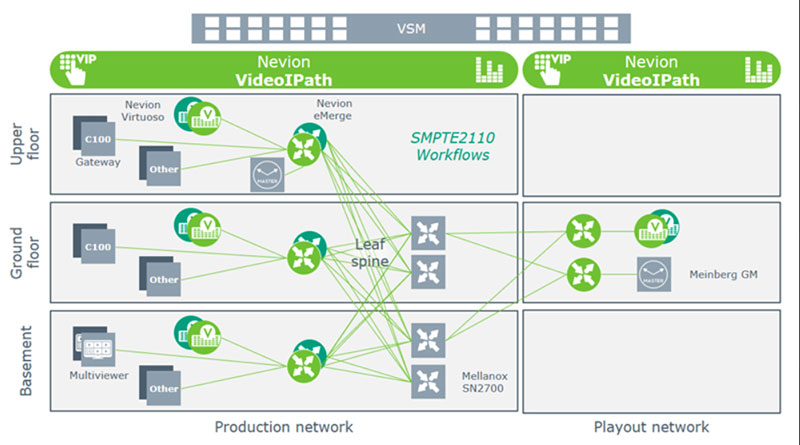Nevion and Sony are integrating essential broadcast control functionality into VideoIPath media orchestration platform, used to route video, audio and data across both SDI and IP networks.

Using VideoIPath to plan broadcast workflows.
Nevion is integrating essential broadcast control functionality into its VideoIPath media orchestration platform. The aim is a consistent system for both broadcast control and network orchestration, capable of supporting the complete production lifecycle from engineering and set-up to production and tear-down. It will also make it simpler and more cost-effective to deploy, roll out and upgrade workflow control.
When IP systems are used, live production workflows are generally simpler to adapt and allow resources like studios, control rooms, equipment and people to be shared across locations. Both factors make remote and distributed production less costly and less disruptive. Nevion says that the key to achieving this transformation is the ability to connect and directly control equipment within and across locations in a unified way.
SDI and IP Networks
Nevion VideoIPath is used to route video, audio and data across both SDI and IP networks (both Internet Group Management Protocol and software-defined networking), connecting locations, equipment and functionality. Deployed by broadcasters and telecom service providers in both local (LAN) and wide (WAN) area networks applications around the world, Nevion VideoIPath manages the underlying interconnections and the resource capacity, which becomes more complex when transitioning live production from SDI to IP.
Sony and Nevion are currently taking advantage of Sony’s expertise in broadcast control to enhance VideoIPath’s capabilities. Initially, the focus is on developing broadcast control functionality for IP-based broadcast facilities, MCRs, production (OB) trucks and other mobile production units.

A software defined network (SDN), based on a spine-leaf network architecture
In the first release, to be shown at the NAB Show 2022, the new functionality will include tally distribution, salvos, alias naming, endpoint grouping, destination monitoring, a soft-panel application for operators and other feature enhancements to VideoIPath’s GUI.
Arne-Johan Martinsen, VideoIPath Product Manager at Nevion said, “As well as immediately benefitting users, this enhancement paves the way towards our vision of a fully distributed production in which resources can be involved in production, almost regardless of their location.”
NS-BUS Management Protocol
The release will also add Sony’s NS-BUS IP-based management protocol, as defined in the system layer of Sony’s IP Live Production System, to the equipment interfaces that VideoIPath already supports. NS-BUS is used to switch the cross-point from the hardware control panel or an external management system through the IP Live System Manager.
NS-BUS specifications are open to third-party vendors to develop UI applications and external management systems. Adding NS-BUS will allow VideoIPath to work with Sony’s hardware panels (MKS-R1620 /R1630/R3210/R4020) and manage connections to Sony’s SDI-IP converters (NXLK-IP51Y and NXLK-IP50Y) and XVS series switchers.
Further functionality will be integrated over time that will help broadcasters work through the transition to dynamic IP production distributed workflows. At the same time, Sony and Nevion remain committed to maintaining VideoIPath as an open, vendor-neutral platform. It allows integration with other 3rd party systems and devices, including broadcast control, to give users a choice. nevion.com




